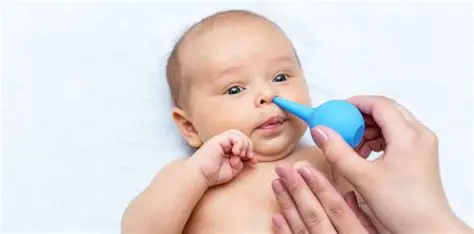A baby’s tiny nasal passages are incredibly sensitive and prone to congestion. Unlike adults, infants and young children are obligate nose breathers for the first few months of life, meaning they primarily breathe through their noses. When their nose is stuffy, it can significantly impact their ability to feed, sleep, and even breathe comfortably. Blocked nasal passages can lead to fussiness, poor feeding, and disturbed sleep.
Congestion in babies can be caused by various factors, including common colds, allergies, dry air, or simply tiny boogers (mucus, or dried nasal secretions) that they can’t effectively clear on their own. Since babies cannot blow their noses, parents must assist them. The goal is always to clear the nasal passages as gently and effectively as possible, minimizing any discomfort for the baby. Proper nasal hygiene is a cornerstone of infant care, ensuring comfort and promoting healthy breathing.
Historically, mothers and caregivers have used various methods, from simple breast milk drops to more modern devices. Today, medical professionals widely recommend specific, gentle approaches to ensure safety and efficacy.
Essential Supplies for Gentle Nose Cleaning
Before you begin, gather the necessary tools. Having everything ready will make the process quicker and less stressful for both you and your baby.
- Saline Nasal Drops or Spray: This is a sterile saltwater solution, available over-the-counter at pharmacies. It helps thin and loosen mucus, making it easier to remove. Ensure it’s specifically formulated for infants.
- Why saline? Saline is isotonic, meaning it has the same salt concentration as the body’s fluids. This prevents irritation and safely moistens the delicate nasal lining.
- Nasal Aspirator:
- Bulb Syringe (Bulb Aspirator): A simple, squeezable rubber bulb with a small tip.
- Nasal Sucker/Snot Sucker (Manual Aspirator): These typically involve a tube with a mouthpiece for the parent to draw suction, connected to a collection chamber and a soft tip for the baby’s nostril. Brands like NoseFrida are popular examples.
- Electric Nasal Aspirator: Battery-operated devices that provide continuous, gentle suction.
- Soft Tissues or Cotton Swabs (Optional): For wiping away excess mucus.
- Clean Towel or Burp Cloth: To protect your clothing and the baby’s.
- Comfort Item (Optional): A favorite toy or blanket to distract and soothe your baby.
Step-by-Step Guide to Cleaning a Baby’s Nose
The key to successful and comfortable nose cleaning is a calm approach and correct technique.
Method 1: Using Saline Drops and a Nasal Aspirator (Most Common)
This is the most widely recommended and effective method for clearing congestion.
- Prepare Your Baby:
- Position: Lay your baby on their back on a changing table, bed, or your lap. Ensure their head is slightly tilted back. This position helps the saline solution flow into the nasal passages.
- Secure: Gently but firmly hold your baby’s head to prevent sudden movements. You might need assistance from another adult, especially with a squirmy baby. A comforting voice and a calm demeanor can help reassure your baby.
- Administer Saline Drops:
- Dosage: Squeeze 2-3 drops of saline solution into each nostril. For a spray, a quick, gentle puff into each nostril is usually sufficient.
- Wait: Allow the saline to sit for 30-60 seconds. This crucial waiting period allows the saline to soften and thin the mucus, making it easier to remove. You might hear gurgling sounds, which is normal.
- Use the Nasal Aspirator:
- Bulb Syringe:
- Squeeze: Squeeze the bulb of the aspirator completely to expel all the air.
- Insert: Gently place the tip of the squeezed bulb just inside one of your baby’s nostrils. Do not insert it too deeply.
- Release: Slowly release the bulb to create suction, drawing mucus into the bulb.
- Remove & Clean: Remove the aspirator, empty the mucus into a tissue, and rinse the tip with warm water before repeating for the other nostril.
- Nasal Sucker/Snot Sucker (e.g., NoseFrida):
- Position: Place the tip firmly against (not inside) the opening of your baby’s nostril, creating a seal.
- Suction: Place the mouthpiece in your mouth and gently suck to create continuous, controlled suction. The filter prevents mucus from reaching your mouth.
- Repeat: Remove the aspirator, clear the mucus, and repeat for the other nostril.
- Electric Nasal Aspirator:
- Activate: Turn on the device and select a gentle suction setting.
- Insert & Suction: Gently place the tip just inside your baby’s nostril and allow the device to create continuous suction.
- Move: Slowly move the tip to clear mucus.
- Repeat & Clean: Remove, clean the tip, and repeat for the other nostril.
- Bulb Syringe:
- Wipe and Soothe:
- Use a soft tissue or a damp cotton swab to gently wipe away any excess mucus from around the nostrils.
- Offer comfort, a hug, or a feed to help your baby settle down.
Method 2: Clearing Surface Mucus with a Damp Cloth
For visible, dried mucus around the nostrils, or if your baby is only mildly congested.
- Warm, Damp Cloth: Dampen a clean, soft cloth or cotton ball with warm (not hot) water.
- Gentle Wipe: Gently wipe the outer edges of your baby’s nostrils to remove any crusty or visible mucus.
- Avoid Pushing In: Never push the cloth or cotton swab into the nostril, as this can push the mucus further in or irritate the delicate skin.
Method 3: Using a Humidifier
While not a direct cleaning method, a humidifier helps prevent and alleviate congestion by adding moisture to the air, which keeps mucus thin and flowing.
- Cool Mist Humidifier: Place a cool mist humidifier in your baby’s room, especially during sleep.
- Clean Regularly: Ensure you clean the humidifier daily or as per manufacturer instructions to prevent mold and bacteria growth.
- Optimal Humidity: Aim for a humidity level of 40-60% in the room.
Important Considerations and Safety Tips
- Sterilize Equipment: Always clean and sterilize your nasal aspirator after each use according to the manufacturer’s instructions. This prevents the spread of germs and re-infection.
- Do Not Overuse Saline: While generally safe, excessive use of saline can sometimes cause irritation. Use it when necessary, typically before feeding or sleeping, or as recommended by your pediatrician.
- Never Use Adult Nasal Sprays: Adult nasal decongestant sprays are too strong for babies and can be dangerous. Only use saline solutions specifically designed for infants.
- Avoid Cotton Swabs Inside the Nose: Never insert cotton swabs, your finger, or any other object into your baby’s nostril. This can injure the delicate nasal lining, push mucus further in, or even cause bleeding.
- Consult Your Pediatrician:
- If your baby has difficulty breathing, is very distressed, or has a fever.
- If congestion persists for several days despite home remedies.
- If you see green or yellow mucus that lasts for more than a few days, or if it’s accompanied by other symptoms of illness.
- If your baby is having trouble feeding due to congestion.
- Stay Calm: Babies can sense your anxiety. Approaching the task calmly and speaking in a soothing voice will help your baby remain more cooperative.
- Timing: Try to clean your baby’s nose before feeds and sleep. This ensures they can feed and rest more comfortably.
Conclusion
Cleaning a baby’s nose is a common parental task that, when done correctly, can significantly improve your baby’s comfort and well-being. By using saline drops to loosen mucus and a gentle nasal aspirator to remove it, you can effectively clear their tiny airways. Remember to maintain hygiene, proceed with care, and always prioritize your baby’s comfort. With practice, this essential part of infant care will become a routine that helps your little one breathe easy.
FAQ
Q1: How often should I clean my baby’s nose?
You should clean your baby’s nose only when necessary, typically when you notice signs of congestion affecting their breathing, feeding, or sleep. This might be a few times a day during a cold, or only occasionally for dry boogers. Over-cleaning can cause irritation.
Q2: Is a bulb syringe or a snot sucker better for cleaning a baby’s nose?
Both bulb syringes and snot suckers (manual aspirators like NoseFrida) are effective. Many parents find snot suckers more effective as they allow for greater, more consistent suction and are often easier to clean. Bulb syringes are simpler and more affordable, but can be harder to clean thoroughly. Electric aspirators offer convenience and consistent suction. The “best” choice often comes down to personal preference and what works best for your baby.
Q3: Can I use breast milk to clear my baby’s stuffy nose?
While breast milk has natural antibodies and can be soothing, its effectiveness as a nasal decongestant is debated by medical professionals. Saline drops are specifically formulated to thin mucus and are widely recommended due to their proven safety and efficacy. It’s best to stick with sterile saline solutions for nasal hygiene.
Q4: What if my baby hates having their nose cleaned?
It’s common for babies to resist nose cleaning. Try these tips:
- Timing: Do it when they are calm and rested, not hungry or fussy.
- Distraction: Sing a song, talk to them gently, or offer a toy.
- Quick & Efficient: Be prepared and perform the cleaning swiftly.
- Comfort: Immediately after, offer a cuddle, a feed, or a pacifier to soothe them.
- Warm Bath: Sometimes a warm bath can naturally loosen mucus before cleaning.
Q5: What are the signs that my baby’s stuffy nose needs attention?
Look for these signs:
- Noisy breathing: Snorting, wheezing, or whistling sounds.
- Difficulty feeding: Breaking suction frequently during breastfeeding or bottle-feeding.
- Disturbed sleep: Waking up frequently or appearing restless.
- Mouth breathing: If your baby is consistently breathing through their mouth, especially while awake.
- Visible mucus or boogers blocking the nostrils.
Q6: Can a humidifier help with a baby’s stuffy nose?
Yes, a cool mist humidifier is a helpful tool. It adds moisture to the air, which can thin nasal secretions, making them easier to drain or remove. This can prevent congestion from worsening and provide relief, especially overnight. Always clean the humidifier regularly to prevent mold.
Q7: When should I be concerned about my baby’s congestion and see a doctor?
You should contact your pediatrician if your baby:
- Is under 3 months old and has a fever.
- Has difficulty breathing or is breathing very rapidly.
- Is refusing to feed or showing signs of dehydration (fewer wet diapers).
- Is unusually lethargic or unresponsive.
- Develops a persistent cough or ear pain.
- Nasal discharge changes to thick green/yellow and persists for several days with other symptoms.
- Congestion lasts for more than a week or two without improvement.





